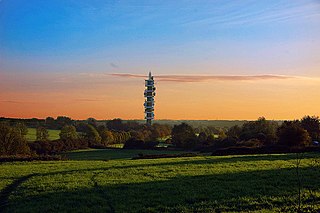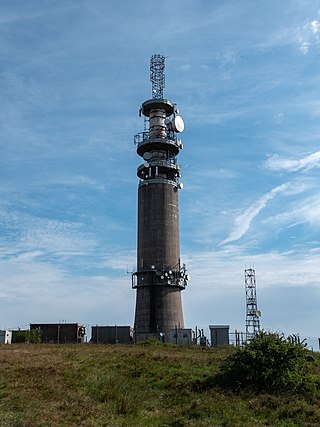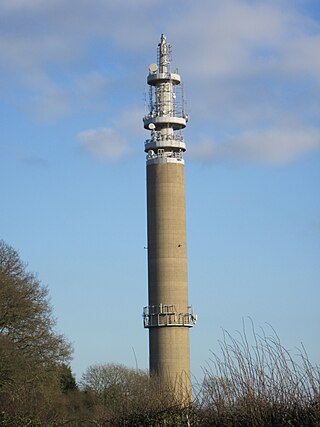The Isle of Man has an extensive communications infrastructure consisting of telephone cables, submarine cables, and an array of television and mobile phone transmitters and towers.
The services of communication in Jersey comprise Internet, telephone, broadcasting and postal services, which allow islanders to contact people and receive information.
Telecommunications in the United Kingdom have evolved from the early days of the telegraph to modern broadband and mobile phone networks with Internet services.

The Office of Communications, commonly known as Ofcom, is the government-approved regulatory and competition authority for the broadcasting, telecommunications and postal industries of the United Kingdom.

A cell site, cell phone tower, cell base tower, or cellular base station is a cellular-enabled mobile device site where antennas and electronic communications equipment are placed to create a cell, or adjacent cells, in a cellular network. The raised structure typically supports antenna and one or more sets of transmitter/receivers transceivers, digital signal processors, control electronics, a GPS receiver for timing, primary and backup electrical power sources, and sheltering.

The Belmont transmitting station is a broadcasting and telecommunications facility next to the B1225, 1 mile (1.6 km) west of the village of Donington on Bain in the civil parish of South Willingham, near Market Rasen and Louth in Lincolnshire, England. It is owned and operated by Arqiva.

The Peterborough transmitting station is a broadcasting and telecommunications facility at Morborne Hill, near Peterborough, England.
Arqiva is a British telecommunications company which provides infrastructure, broadcast transmission and smart meter facilities in the United Kingdom. The company is headquartered at the former Independent Broadcasting Authority headquarters in Crawley, Hampshire, England. Its main customers are broadcasters and utility companies, and its main asset is a network of circa. 1,500 radio and television transmission sites. It is owned by a consortium of investors led by Digital 9 Infrastructure and the Australian investment house Macquarie Bank. Arqiva is a patron of the Radio Academy.

The Rowridge transmitting station is a facility for FM radio and television transmission at Rowridge on the Isle of Wight in southern England.

The Wenvoe transmitting station, officially known as Arqiva Wenvoe, is the main facility for broadcasting and telecommunications for South Wales and the West Country. It is situated close to the village of Wenvoe in the Vale of Glamorgan, Wales, in the UK.

Purdown BT Tower, also known as Purdown Transmitter, is a 70.1 metres (230 ft) tall telecommunications tower in Bristol, England. Built in 1970 for the British Telecom microwave network, it is now used to transmit radio and provide mobile phone coverage.

Sutton Common BT Tower is a 72-metre (238-foot) radio tower built of reinforced concrete at Macclesfield, Cheshire, England. Sutton Common was originally conceived as part of the 1950s 'Backbone' chain designed to provide the UK and NATO with survivable communications during nuclear war.

The Heaton Park BT Tower is a 238-foot (73 m) tall concrete telecommunications tower located next to Heaton Park Reservoir in Manchester, England. Heaton Park BT Tower is one of the few British towers built of reinforced concrete, and one of seven BT towers of the 'Chilterns' design.

The Tinshill BT Tower is a 60.96 metres ( 200 ft) tall telecommunication tower located on the east side of Otley Old Road in the north of Leeds, West Yorkshire, England. It is in an elevated part of Leeds, with its base 192 metres above sea level. It is one of fourteen BT towers built of reinforced concrete.

Stokenchurch BT Tower is a telecommunications tower built of reinforced concrete at Stokenchurch, Buckinghamshire, England. Reaching to 340.5 metres (1,117 ft) above mean sea level, it dates from 1963 and is 99.4 metres (326 ft) tall. There are four platforms at the top that are used to attach microwave transmission drums and other antennas.

Morgan's Hill is a 12.6-hectare (31-acre) biological Site of Special Scientific Interest between Calne and Devizes in Wiltshire, England. The SSSI was notified in 1951 and again in 1987.
The following outline is provided as an overview of and topical guide to telecommunication:

Due to economy of scale property of telecommunication industry, sharing of telecom infrastructure among telecom service providers is becoming the requirement and process of business in the telecom industry where competitors are becoming partners in order to lower their increasing investments. The degree and method of infrastructure sharing can vary in each country depending on regulatory and competitive climate.

Telefonica UK Limited, trading as O2 (stylised as O2), is a British telecommunications services provider, headquartered in Reading, England which operates under the O2 brand. It is owned by VMED O2 UK Limited, a 50:50 joint venture between Telefónica and Liberty Global. O2 is the UK's largest mobile network operator, with 23.8 million subscribers as of May 2023.
Cellnex Telecom is a Spanish wireless telecommunications infrastructure and services company with up to 135,000 sites -including forecast roll-outs up to 2030- throughout Europe. Its activity is divided into four main areas: services for telecommunications infrastructures; audiovisual broadcasting networks; security and emergency network services; and solutions for the intelligent management of urban infrastructures and services.














